User:Mr.Z-man/withrefs
State of Israel מְדִינַת יִשְׂרָאֵל (in Hebrew) Medīnat Yisrā'el دَوْلَةُ إِسْرَائِيلَ (in Arabic) Dawlat Isrā'īl | ||
|---|---|---|
| Anthem: Knesset Speaker | Reuven Rivlin | |
| Dorit Beinisch | ||
| Independence | ||
| May 14, 1948 | ||
| Area | ||
• Total 1 | 20770⁄22072 km2 (0.36333 sq mi) (151st) | |
• Water (%) | ~2% | |
| Population | ||
• 2010 estimate | 7,587,000[3] (96th) | |
• 1995 census | 5,612,300[4] | |
• Density | 365.3/km2 (946.1/sq mi) (35th) | |
| GDP (PPP) | 2009 estimate | |
• Total | $206.430 billion[5] (49th) | |
• Per capita | $28,393[5] (29th) | |
| GDP (nominal) | 2009 estimate | |
• Total | $194.825 billion[5] (40th) | |
• Per capita | $26,796[5] (28th) | |
| Gini (2008) | 39.2[1] Error: Invalid Gini value | |
| HDI (2007) | Error: Invalid HDI value (27th) | |
| Currency | Shekel (₪) (ILS or NIS) | |
| Time zone | UTC+2 (IST) | |
• Summer (DST) | UTC+3 (IDT) | |
| Driving side | right | |
| Calling code | 972 | |
| ISO 3166 code | IL | |
| Internet TLD | .il | |
| ||
Israel (
The modern State of Israel has its historical and religious roots in the Biblical
In November 1947, the
Israel is a developed country and a representative democracy with a parliamentary system and universal suffrage.[18][19] The Prime Minister serves as head of government and the Knesset serves as Israel's legislative body. The economy, based on the nominal gross domestic product, was the 41st-largest in the world in 2008.[20] Israel ranks highest among Middle Eastern countries on the UN Human Development Index,[21] and has one of the highest life expectancies in the world.[22] Jerusalem is the country's capital, although it is not recognized internationally as such,[a] while Israel's main financial center is Tel Aviv. In 2010, Israel was accepted as member to the OECD.[23]
Etymology
Over the past three thousand years, the
The earliest archaeological artifact to mention "Israel" (other than as a personal name) is the
History
Antiquity
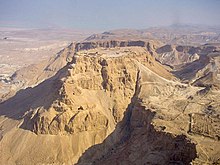
The
Between the time of the Israelite kingdoms and the 7th-century
Zionism and the British Mandate
Jews living in the Diaspora have long aspired to return to Zion and the Land of Israel,[47] though the amount of human effort that should be spent towards such aim is a matter of dispute in Judaism.[48][49] That hope and yearning was articulated in the Bible,[50] and is an important theme of the Jewish belief system.[48] After the Jews were expelled from Spain in 1492, some communities settled in Palestine.[51] During the 16th century, communities struck roots in the Four Holy Cities — Jerusalem, Tiberias, Hebron, and Safed — and in 1697, Rabbi Yehuda Hachasid led a group of 1500 Jews to Jerusalem.[52] In the second half of the 18th century, Eastern European opponents of Hasidism, known as the Perushim, settled in Palestine.[53][54][55]

The first large wave of "modern" immigration, known as the
The
The
The
Independence and first years
After 1945,
The Jewish community accepted the plan,[70] but the Arab League and Arab Higher Committee rejected it.[71] On December 1, 1947, the Arab Higher Committee proclaimed a three-day strike, and Arab bands began attacking Jewish targets.[72] Jews were initially on the defensive as civil war broke out, but they gradually moved onto the offensive.[73] The Palestinian Arab economy collapsed and 250,000 Palestinian-Arabs fled or were expelled.[74]
On May 14, 1948, the day before the expiration of the British Mandate, the
In the early years of the state, the
In the 1950s, Israel was frequently attacked by Palestinian fedayeen, mainly from the Egyptian-occupied Gaza Strip.[89] In 1956, Israel joined a secret alliance with Great Britain and France aimed at regaining control of the Suez Canal, which the Egyptians had nationalized (see the Suez Crisis). Israel captured the Sinai Peninsula but was pressured to withdraw by the United States and the Soviet Union in return for guarantees of Israeli shipping rights in the Red Sea and the Canal.[90][91]
In the early 1960s, Israel captured Nazi war criminal Adolf Eichmann, an architect of the Final Solution, in Argentina and brought him to trial.[92] The trial had a major impact on public awareness of the Holocaust,[93] and Eichmann remains the only person ever to be executed by order of an Israeli court.[94]
Conflicts and peace treaties

Arab nationalists led by Egyptian President Gamal Abdel Nasser refused to recognize Israel or its right to exist, calling for its destruction.[17][95] By 1966, Israeli-Arab relations had deteriorated to the point of actual battles taking place between official Israeli and Arab forces.[96] In 1967, Egypt expelled UN peacekeepers, stationed in the Sinai Peninsula since 1957, and announced a partial blockade of Israel's access to the Red Sea.[97] Israel saw these actions as a casus belli for a pre-emptive strike that launched the Six-Day War, in which Israel achieved a decisive victory and captured the West Bank, Gaza Strip, Sinai Peninsula and Golan Heights.[98] Jerusalem's boundaries were enlarged, incorporating East Jerusalem, and the 1949 Green Line became the administrative boundary between Israel and the occupied territories.
The failure of the Arab states in the 1967 war led Arab non-state actors to have a more central role in the conflict. Most important among them is the
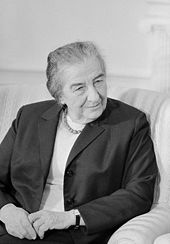
On October 6, 1973, as Jews were observing Yom Kippur, the Egyptian and Syrian armies launched a surprise attack against Israel. The war ended on October 26 with Israel successfully repelling Egyptian and Syrian forces but suffering great losses.[104] An internal inquiry exonerated the government of responsibility for failures before and during the war, but public anger forced Prime Minister Golda Meir to resign.[105]
The
The
In 1982, Israel intervened in the Lebanese Civil War to destroy the bases from which the PLO launched attacks and missiles at northern Israel; that move developed into the First Lebanon War.[112] Israel withdrew from most of Lebanon in 1986, but maintained a borderland buffer zone until 2000. The First Intifada, a Palestinian uprising against Israeli rule,[113] broke out in 1987 with waves of violence occurring in the occupied territories. Over the following six years, more than a thousand people were killed in the ensuing violence, much of which was internal Palestinian violence.[114] During the 1991 Gulf War, the PLO and many Palestinians supported Saddam Hussein and Iraqi missile attacks against Israel.[115][116]
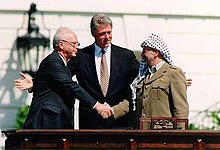
In 1992,
At the end of the 1990s, Israel, under the leadership of
In July 2006, a
Geography and climate
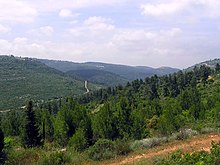
Israel is located at the eastern end of the Mediterranean Sea, bounded by Lebanon to the north, Syria to the northeast, Jordan to the east, and Egypt to the southwest. The sovereign territory of Israel, excluding all territories captured by Israel during the 1967 Six-Day War, is approximately 20,770 square kilometers (8,019 sq mi) in area, of which two percent is water.[1] The total area under Israeli law, including East Jerusalem and the Golan Heights, is 22,072 square kilometers (8,522 sq mi).[133] The total area under Israeli control, including the military-controlled and partially Palestinian-governed territory of the West Bank, is 27,799 square kilometers (10,733 sq mi).[134]
Despite its small size, Israel is home to a variety of geographic features, from the
Unique to Israel and the
Temperatures in Israel vary widely, especially during the winter. The more mountainous regions can be windy, cold, and sometimes snowy; Jerusalem usually receives at least one snowfall each year.[140] Meanwhile, coastal cities, such as Tel Aviv and Haifa, have a typical Mediterranean climate with cool, rainy winters and long, hot summers. The highest temperature in the continent of Asia (53.7 °C (128.7 °F)*) was recorded in 1942 at Tirat Zvi kibbutz in the northern Jordan river valley.[141] From May to September, rain in Israel is rare.[142][143] With scarce water resources, Israel has developed various water-saving technologies, including drip irrigation.[144] Israelis also take advantage of the considerable sunlight available for solar energy, making Israel the leading nation in solar energy use per capita.[145]
Government and politics

Israel operates under a
Parliamentary elections are scheduled every four years, but unstable coalitions or a
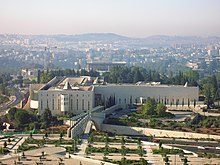
Israel has a
Israel's legal system combines
Administrative districts
The State of Israel is divided into six main administrative districts, known as mehozot (מחוזות; singular: mahoz) –
For statistical purposes, the country is divided into three metropolitan areas:
Occupied territories
In 1967, as a result of the
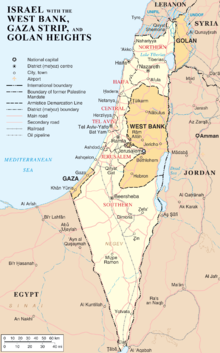
Following Israel's capture of these territories,
The status of East Jerusalem in any future peace settlement has at times been a difficult hurdle in negotiations between Israeli governments and representatives of the Palestinians. Most negotiations relating to the territories have been on the basis of United Nations Security Council Resolution 242, which calls on Israel to withdraw from occupied territories in return for normalization of relations with Arab states, a principle known as "Land for peace".[170][171][172]
The West Bank was annexed by Jordan in 1948, following the Arab rejection of the UN decision to create two states in Palestine. Only Britain recognized this annexation and Jordan has since
The
Foreign relations
Israel maintains diplomatic relations with 161 countries and has 94
As a result of the 2009 Gaza War, Mauritania, Qatar, Bolivia, and Venezuela suspended political and economical ties with Israel.[182][183] Under Israeli law, Lebanon, Syria, Saudi Arabia, Iraq, and Yemen are enemy countries[184] and Israeli citizens may not visit them without permission from the Ministry of the Interior.[185] Since 1995, Israel has been a member of the Mediterranean Dialogue, which fosters cooperation between seven countries in the Mediterranean Basin and the members of the North Atlantic Treaty Organization.[186]

Foreign relations with
India established full diplomatic ties with Israel in 1992 and has fostered a strong military and cultural partnership with the country since then.[189] One study revealed that India was the most pro-Israel nation in the world followed by the United States.[190]
Although Turkey and Israel did not establish full diplomatic relations until 1991,[196] Turkey has cooperated with the State since its recognition of Israel in 1949. Turkey's ties to the other Muslim-majority nations in the region have at times resulted in pressure from Arab states to temper its relationship with Israel.[197] Relations between Turkey and Israel took a downturn, however, after the former's condemnation of Israel after the 2009 Gaza War.[182]
In Africa, Ethiopia is Israel's main and closest ally in the continent due to common political, religious and security interests.[198] Many towns in Ethiopia are named after biblical Israel settlements, including Ethiopia's third largest city of Nazret Adama. Israel also provides expertise to Ethiopia on irrigation projects. Thousands of Ethiopian Jews (Beta Israel) live in Israel.
Defense
The Israel Defense Forces consists of the Israeli Army, Israeli Air Force and Israeli Navy. It was founded during the 1948 Arab-Israeli War by consolidating paramilitary organizations—chiefly the Haganah—that preceded the establishment of the state.[199] The IDF also draws upon the resources of the Military Intelligence Directorate (Aman), which works with the Mossad and Shabak.[200] The Israel Defense Forces have been involved in several major wars and border conflicts in its short history, making it one of the most battle-trained armed forces in the world.[201][202]
The majority of Israelis are
The nation's military relies heavily on
Israel is widely believed to
After the Gulf War in 1991, when Israel was attacked by Iraqi Scud missiles, a law was passed requiring all apartments and homes in Israel to have a mamad, a reinforced security room impermeable to chemical and biological substances.[214]
Economy
Israel is considered one of the most advanced countries in
In 2009, Israel had the 49th-highest
Despite limited natural resources, intensive development of the
Israel is a global leader in
Tourism
Tourism, especially religious tourism, is an important industry in Israel, with the country's temperate climate, beaches, archaeological and historical sites, and unique geography also drawing tourists. Israel's security problems have taken their toll on the industry, but the number of incoming tourists is on the rebound.[229] In 2008, over 3 million tourists visited Israel.[230]
Transportation
Israel has 18,096 kilometers (11,244 mi) of paved roads,[231] and 2.4 million motor vehicles.[232] The number of motor vehicles per 1,000 persons was 324, relatively low with respect to developed countries.[232] Israel has 5,715 buses on scheduled routes,[233] operated by several carriers, the largest of which is Egged, serving most of the country. Railways stretch across 949 kilometers (590 mi) and are operated solely by government-owner Israel Railways[234] (All figures are for 2008). Following major investments beginning in the early-to-mid 1990s, the number of train passengers per year has grown from 2.5 million in 1990, to 35 million in 2008; railways are also used to transport 6.8 million tons of cargo, per year.[234]
Israel is served by two international airports,
On the
Science, technology and education
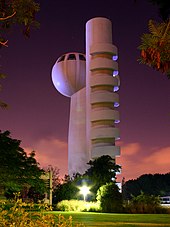
Israel has the highest school life expectancy in
Education is
Israel's eight public universities are subsidized by the state.

Israel leads world in stem cell research papers per capita since 2000
In 2009 Israel was ranked 2nd among 20 top countries in space sciences by Thomson Reuters agency.[259] Since 1988 Israel Aerospace Industries have indigenously designed and built at least 13 commercial, research and spy satellites.[260] Most were launched to orbit from Israeli air force base "Palmachim" by the Shavit space launch vehicle. Some of Israel's satellites are ranked among the world's most advanced space systems.[261] In 2003, Ilan Ramon became Israel's first astronaut, serving as payload specialist of STS-107, the fatal mission of the Space Shuttle Columbia.
Israel has embraced
Demographics

As of 2010, Israel's population is 7.5 million.
Many Israelis communicate reasonably well in English, as many television programs are in English and English is taught from the early grades in elementary school. As a country of
Retention of Israel's population since 1948 is about even or greater, when compared to other countries with mass immigration.[279] Emigration from Israel (yerida) to other countries, primarily the United States and Canada, is described by demographers as modest,[280] but is often cited by Israeli government ministries as a major threat to Israel's future.[281][282]
As of 2009 over 300,000 Israeli citizens live in
Israel was established as a homeland for the
Religion
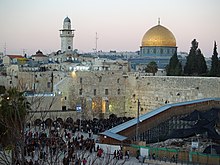
The religious affiliation of Israeli Jews varies widely: 55% say they are "traditional," while 20% consider themselves "secular Jews," 17% define themselves as "Religious Zionists"; the final 8% define themselves as "Haredi Jews."[291]
Making up 16% of the population,
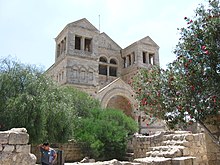
The Christian population includes both
The city of
The administrative center of the
Culture
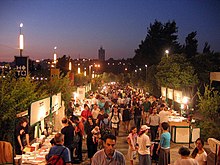
Israel's diverse culture stems from the diversity of the population:
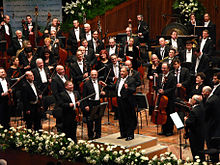

Israeli music contains musical influences from all over the world; Sephardic music, Hasidic melodies, Belly dancing music, Greek music, jazz, and pop rock are all part of the music scene.[306][307] The nation's canonical folk songs, known as "Songs of the Land of Israel," deal with the experiences of the pioneers in building the Jewish homeland.[308] Among Israel's world-renowned[309][310] orchestras is the Israel Philharmonic Orchestra, which has been in operation for over seventy years and today performs more than two hundred concerts each year.[311] Israel has also produced many musicians of note, some achieving international stardom. Itzhak Perlman, Pinchas Zukerman and Ofra Haza are among the internationally acclaimed musicians born in Israel. Israel has participated in the Eurovision Song Contest nearly every year since 1973, winning the competition three times and hosting it twice.[312] Eilat has hosted its own international music festival, the Red Sea Jazz Festival, every summer since 1987.[313]
Continuing the strong
The
Sports
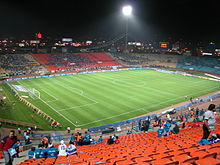
Sports and physical fitness have not always been paramount in Jewish culture. Athletic prowess, which was prized by the

Israel was excluded from the 1978 Asian Games due to Arab pressure on the organizers. The exclusion left Israel in limbo and it ceased competing in Asian competitions.[322] In 1994, UEFA agreed to admit Israel and all Israeli sporting organizations now compete in Europe.
The most popular spectator sports in Israel are
Beersheba has become a national chess center; thanks to Soviet immigration, it is home to the largest number of chess grandmasters of any city in the world.[327] The city hosted the World Team Chess Championship in 2005, and chess is taught in the city's kindergartens.[328] In 2008, the Israeli chess team won the silver medal at the Chess Olympiad.[329] Israeli grandmaster Boris Gelfand is the current Chess World Cup holder.[330]
To date, Israel has won seven Olympic medals since its first win in 1992, including a gold medal in windsurfing at the 2004 Summer Olympics.[331] Israel has won over 100 gold medals in the Paralympic Games and is ranked about 15th in the all-time medal count. The 1968 Summer Paralympics were hosted by Israel.[332]
See also
References and notes
| a. | Positions on Jerusalem for more information.
|
- ^ a b c d e f g h i j k l "Israel", The World Factbook, Central Intelligence Agency, 19 June 2007, retrieved 20 July 2007
- ^ Haaretz Service (16 September 2009), "Israel on eve of Rosh Hoshanah: Population hits 7.5m, 75.4% Jewish", Haaretz, retrieved 26 December 2009
- ^ a b Israel at 62: Population of 7,587,000, Ynet, 18 April 2010
- ^ Localities and population, by municipal status and district (PDF), Israeli Central Bureau of Statistics, 2009, retrieved 19 April 2010
- ^ a b c d e Israel, International Monetary Fund, retrieved 21 April 2010
- ^ Human Development Report 2009. Human development index trends: Table G (PDF), The United Nations, retrieved 10 October 2009
- ^ "Israel", CIA Factbook, CIA, retrieved 13 April 2010
- ^ Skolnik 2007, pp. 132–232
- ^ "Israel", Country Report, Freedom House, 2007, retrieved 15 July 2007
- ^ "Israel closes decade with population of 7.5 million", Haaretz, 31 December 2009, retrieved 31 December 2009
- ^ Time Series-DataBank, Central Bureau of Statistics, retrieved 20 February 2009
- ISBN 978-0674397316
- )
- ^ See, for example, Genesis 12 and 13. Etz Hayim: Torah and Commentary. Jewish Publication Society, 2001.
- ^ "The Palestine Mandate", The Avalon Project, 24 July 1922, retrieved 8 April 2010
- ^ "United Nations General Assembly Resolution 181", The Avalon Project, Yale University, 29 November 1947, retrieved 21 August 2007
- ^ ISBN 978-0415359009
- ^ Rummel 1997, p. 257. "A current list of liberal democracies includes: Andorra, Argentina, ... , Cyprus, ... , Israel, ..."
- ^ Global Survey 2006: Middle East Progress Amid Global Gains in Freedom, Freedom House, 19 December 2005, retrieved 1 July 2007
- ^ Gross domestic product 2008 (PDF), The World Bank, 7 October 2009, retrieved 18 February 2010 Note: this links to the most up-to-date table of GDP and will therefore eventually cease to connect to the table for the year mentioned.
- ^ Human Development Report 2007/2008 (PDF), United Nations Development Programme, retrieved 25 June 2009
- ^ WHO: Life expectancy in Israel among highest in the world Haaretz, May, 2009
- ^ a b Wrobel, Sharon (10 May 2010), OECD accepts Israel as member, Jerusalem Post, retrieved 10 May 2007
- ISSN 0294-8052, retrieved 29 July 2008
- King James Version of the Bible: "And he said, Thy name shall be called no more Jacob, but Israel: for as a prince hast thou power with God and with men, and hast prevailed." (Genesis, 32:28). See also Hosea 12:5.
- ^ Barton & Bowden 2004, p. 126. "The Merneptah Stele... is arguably the oldest evidence outside the Bible for the existence of Israel as early as the 13th century BCE."
- ^ Popular Opinion, The Palestine Post, 7 December 1947, p. 1
- ^ "On the Move", Time, 31 May 1948, retrieved 6 August 2007
- King James Version of the Bible: "And the Lord thy God will bring thee into the land which thy fathers possessed, and thou shalt possess it; and he will do thee good, and multiply thee above thy fathers." (Deuteronomy, 30:5)
- King James Version of the Bible: "But if ye turn unto me, and keep my commandments, and do them; though there were of you cast out unto the uttermost part of the heaven, yet will I gather them from thence, and will bring them unto the place that I have chosen to set my name there." (Nehemiah, 1:9)
- ^ "Walking the Bible Timeline", Walking the Bible, Public Broadcast Television, retrieved 29 September 2007
- ^ Friedland & Hecht 2000, p. 8. "For a thousand years Jerusalem was the seat of Jewish sovereignty, the household site of kings, the location of its legislative councils and courts."
- ISBN 978-0674397316
- ISBN 978-0664224363
- )
- ISBN 978-0674397316
- ISBN 978-0195139419
- ^ Oppenheimer, A'haron and Oppenheimer, Nili. Between Rome and Babylon: Studies in Jewish Leadership and Society. Mohr Siebeck, 2005, p. 2.
- ISBN 978-0415088008
- ^ "Palestine: History", The Online Encyclopedia of the Roman Provinces, The University of South Dakota, 22 February 2007, retrieved 13 March 2009
- ^ Morçöl 2006, p. 304
- ISBN 0-521-34770-X,
On 5 May, with the help of Jews within the the Persians forced their way into the city. There followed scenes of' utter horror. With their churches and houses in flames around them, the Christians were indiscriminately massacred, some by the Persian soldiery and many more by the Jews. Sixty thousand were said to have perished and thirty-five thousand more were sold into slavery.
- ISBN 978-0674397316
- )
- ^ ISBN 978-0521599849
- ^ ISBN 978-0691118970
- ^ Rosenzweig, p. 1 "Zionism, the urge of the Jewish people to return to Palestine, is almost as ancient as the Jewish diaspora itself. Some Talmudic statements... Almost a millennium later, the poet and philosopher Yehuda Halevi... In the 19th century..."
- ^ a b Geoffrey Wigoder, G.G. (ed.), "Return to Zion", The New Encyclopedia of Judaism (via Answers.Com), The Jerusalem Publishing House, retrieved 8 March 2010
{{citation}}:|author=has generic name (help) - ^ An invention called 'the Jewish people' – Haaretz – Israel News, Ha'aretz, retrieved 9 March 2010
- King James Version of the Bible: "the Lord your God will bring you back from captivity ... and gather you again from all the peoples ... and will bring you into the land which your fathers possessed and you shall possess it" (Deut. 30:1–5).
- ^ Gilbert 2005, p. 2 harvnb error: multiple targets (2×): CITEREFGilbert2005 (help). "Jews sought a new homeland here after their expulsions from Spain (1492)..."
- ISBN 1-56871-323-1
- ISBN 978-0195305784
- ^ Jewish and Non-Jewish Population of Palestine-Israel (1517–2004), Jewish Virtual Library, retrieved 29 March 2010
- ISBN 978-0817305727
- ^ a b c d "Immigration", Jewish Virtual Library, The American-Israeli Cooperative Enterprise, retrieved 12 July 2007 The source provides information on the First, Second, Third, Fourth and Fifth Aliyot in their respective articles. The White Paper leading to Aliyah Bet is discussed [1].
- ^ Kornberg 1993 "How did Theodor Herzl, an assimilated German nationalist in the 1880s, suddenly in the 1890s become the founder of Zionism?"
- ^ Herzl 1946, p. 11
- ^ Chapter One: The Heralders of Zionism, Jewish Agency for Israel, retrieved 12 July 2007
- ^ Stein 2003, p. 88. "As with the First Aliyah, most Second Aliyah migrants were non-Zionist orthodox Jews..."
- ^ Romano 2003, p. 30
- ^ Macintyre, Donald (26 May 2005), "The birth of modern Israel: A scrap of paper that changed history", The Independent, London, retrieved 7 January 2009
- ^ Scharfstein 1996, p. 269. "During the First and Second Aliyot, there were many Arab attacks against Jewish settlements... In 1920, Hashomer was disbanded and Haganah ("The Defense") was established."
- ^ "League of Nations: The Mandate for Palestine, July 24, 1922", Modern History Sourcebook, Fordham University, 24 July 1922, retrieved 27 August 2007
- ^ J. V. W. Shaw , "A Survey of Palestine, Vol 1: Prepared in December 1945 and January 1946 for the Information of the Anglo-American Committee of Inquiry", Reprinted 1991 by The Institute for Palestine Studies, Washington, D.C., page 148
- ^ The Population of Palestine Prior to 1948, MidEastWeb, retrieved 12 July 2007
- ^ Fraser 2004, p. 27
- ^ "Background Paper No. 47 (ST/DPI/SER.A/47)" (Document). United Nations. 20 April 1949.
{{cite document}}: Unknown parameter|accessdate=ignored (help); Unknown parameter|url=ignored (help) - ^ Best 2003, pp. 118–9
- ^ History: Foreign Domination, Israel Ministry of Foreign Affairs, 1 October 2006, retrieved 6 July 2007
- ^ Bregman 2002, p. 40–1
- ISBN 978-1902210674
- ISBN 978-0714652757
- ISBN 978-0300151121
- ^ Clifford, Clark, "Counsel to the President: A Memoir", 1991, P 20.
- ^ "Part 3: Partition, War and Independence", The Mideast: A Century of Conflict, National Public Radio, 2 October 2002, retrieved 13 July 2007
- )
- ISBN 978-1841763729
- ^ "Two Hundred and Seventh Plenary Meeting" (Document). The United Nations. 11 May 1949.
{{cite document}}: Unknown parameter|accessdate=ignored (help); Unknown parameter|url=ignored (help) - ^ "General Progress Report and Supplementary Report of the United Nations Conciliation Commission for Palestine, Covering the Period from December 11, 1949 to October 23, 1950" (Document). The United Nations Conciliation Commission. 23 October 1950.
{{cite document}}: Unknown parameter|accessdate=ignored (help); Unknown parameter|url=ignored (help) (U.N. General Assembly Official Records, Fifth Session, Supplement No. 18, Document A/1367/Rev. 1) - ^ Van Evera, Stephen, "Nature of the Flashpoint" (PDF), Center for International Studies, Massachusetts Institute of Technology, retrieved 11 September 2007
- ^ Reveron & Murer 2006
- ^ Lustick 1988, pp. 37–9
- ^ "Israel (Labor Zionism)", Country Studies, Library of Congress, retrieved 12 February 2010
- ISBN 978-0826447647
- ^ Population, by Religion and Population Group, Israel Central Bureau of Statistics, 2006, retrieved 7 August 2007
- ISBN 978-0815629696; for ma'abarot population, see p. 269.
- ^ Shindler 2002, pp. 49–50
- ^ Gilbert 2005, p. 58 harvnb error: multiple targets (2×): CITEREFGilbert2005 (help)
- ^ The Suez Crisis, University of San Diego, 5 December 2005, retrieved 15 July 2007
- )
- ^ Adolf Eichmann, Jewish Virtual Library, retrieved 18 September 2007
- ^ Cole 2003, p. 27. "...the Eichmann trial, which did so much to raise public awareness of the Holocaust..."
- ^ Justice Ministry Reply to Amnesty International Report, Israel Ministry of Foreign Affairs, 5 July 1995, retrieved 10 August 2007
- ISBN 978-0198280187
- ^ Segev 2007, p. 178
- ^ Segev 2007, p. 289
- ^ Smith 2006, p. 126. "Nasser, the Egyptian president, decided to mass troops in the Sinai...casus belli by Israel."
- ^ Bennet, James (13 March 2005), "The Interregnum", The New York Times Magazine, retrieved 11 February 2010
- ^ Israel Ministry of Foreign Affairs – The Palestinian National Covenant- July 1968, Mfa.gov.il, retrieved 13 March 2009
- ISBN 978-0714653112, retrieved 8 March 2010)
{{citation}}: More than one of|pages=and|page=specified (help - ISBN 978-0415281164, retrieved 8 March 2010)
{{citation}}: More than one of|pages=and|page=specified (help - ^ Andrews, Edmund L. and John Kifner."George Habash, Palestinian Terrorism Tactician, Dies at 82." The New York Times. 2008 Jan 27. 2008 May 12.
- ^ "1973: Arab states attack Israeli forces", On This Day, The BBC, 6 October 1973, retrieved 15 July 2007
- ^ Agranat Commission, Knesset, 2008, retrieved 8 April 2010
- ^ Bregman 2002, pp. 169–70 "In hindsight we can say that 1977 was a turning point..."
- ^ Bregman 2002, pp. 171–4
- ^ Bregman 2002, pp. 186–7
- ^ Bregman 2002, pp. 186
- ISBN 978-0813334899
- ^ See for example UN General Assembly resolution 63/30, 2009 Jan 23, passed 163 for, 6 against [2]
- ^ Bregman 2002, p. 199
- ISBN 978-0253208736
- ^ Stone & Zenner 1994, p. 246. "Toward the end of 1991,... were the result of internal Palestinian terror."
- ^ Haberman, Clyde (9 December 1991), "After 4 Years, Intifada Still Smolders", The New York Times, retrieved 28 March 2008
- ^ Mowlana, Gerbner & Schiller 1992, p. 111
- ^ Bregman 2002, p. 236
- ^ From the End of the Cold War to 2001, Boston College, retrieved 16 July 2007
- ^ The Oslo Accords, 1993, U.S. Department of State, retrieved 30 March 2010
- ^ Israel-PLO Recognition – Exchange of Letters between PM Rabin and Chairman Arafat – Sept 9- 1993, Israeli Ministry of Foreign Affairs, retrieved 31 March 2010
- ^ Harkavy & Neuman 2001, p. 270. "Even though Jordan in 1994 became the second country, after Egypt to sign a peace treaty with Israel..."
- ^ Settlements information, Foundation for Middle East Peace, Sources of Population Growth: Total Israeli Population and Settler Population, 1991–2003, archived from the original on 2008-05-11, retrieved 12 December 2007
{{citation}}: External link in|first= - ^ Bregman 2002, p. 257
- ^ The Wye River Memorandum, U.S. Department of State, 23 October 1998, retrieved 30 March 2010
- ^ Gelvin 2005, p. 240
- ^ Jul 29-west-bank_x.htm West Bank barrier route disputed, Israeli missile kills 2, The Associated Press (via USA Today), 29 July 2004, retrieved 16 July 2007
{{citation}}: Check|url=value (help); Italic or bold markup not allowed in:|publisher=(help) - ^ 'Permanent Ceasefire to Be Based on Creation Of Buffer Zone Free of Armed Personnel Other than UN, Lebanese Forces' United Nations Security Council, August 11, 2006
- escalation of hostilities in Lebanon and in Israel since Hizbollah’s attack on Israel on July 12, 2006 - ^ Harel, Amos (13 July 2006), "Hezbollah kills 8 soldiers, kidnaps two in offensive on northern border", Haaretz, retrieved 13 August 2006
- ^ Walker, Peter (21 May 2008), "Olmert confirms peace talks with Syria", The Guardian, London, retrieved 21 May 2008,
Israel and Syria are holding indirect peace talks, with Turkey acting as a mediator...
{{citation}}: Unknown parameter|coauthors=ignored (|author=suggested) (help) - ^ Koutsoukis, Jason (5 January 2009), Battleground Gaza: Israeli ground forces invade the strip, smh.com.au, retrieved 5 January 2009
- ^ Ravid, Barak (19 January 2009), "IDF begins Gaza troop withdrawal, hours after ending 3-week offensive", Haaretz, retrieved 29 January 2009
- ^ Azoulay, Yuval (1 February 2009), Two IDF soldiers, civilian lightly hurt as Gaza mortars hit Negev, Haaretz, retrieved 12 April 2009
- ^ "Area of Districts, Sub-Districts, Natural Regions and Lakes" (PDF), Statistical Abstract of Israel, Israel Central Bureau of Statistics, 2006
- ^ "Israel (Geography)", Country Studies, The Library of Congress, retrieved 2010-02-12
- ^ The Living Dead Sea, Israel Ministry of Foreign Affairs, 1 April 1999, retrieved 20 July 2007
- ^ Makhteshim Country, UNESCO, retrieved 19 September 2007
- ^ Jacobs 1998, p. 284. "The extraordinary Makhtesh Ramon – the largest natural crater in the world..."
- ^ Makhtesh Ramon, Jewish Virtual Library, retrieved 12 February 2010
- ^ Rinat, Zafrir (2 June 2008), "More endangered than rain forests?", Haaretz, retrieved 29 July 2008
- ^ Goldreich 2003, p. 85
- ^ Watzman, Haim (8 February 1997), Left for dead, retrieved 29 July 2008
- ^ Average Weather for Tel Aviv-Yafo, The Weather Channel, retrieved 11 July 2007
- ^ Average Weather for Jerusalem, The Weather Channel, retrieved 11 July 2007
- ^ Sitton, Dov (20 September 2003), Development of Limited Water Resources- Historical and Technological Aspects, Israeli Ministry of Foreign Affairs, retrieved 7 November 2007
- ^ Grossman, Gershon, Solar energy for the production of heat, Samuel Neaman Institute, retrieved 7 November 2007
{{citation}}: Unknown parameter|coauthors=ignored (|author=suggested) (help) - ^ a b "Field Listing — Executive Branch", The World Factbook, Central Intelligence Agency, 19 June 2007, retrieved 20 July 2007
- ^ In the 1990s, direct elections for Prime Minister were inaugurated but the system was declared unsatisfactory and the old one was brought back. See Israel's election process explained, BBC News, 23 January 2003, retrieved 31 March 2010
- ^ The Electoral System in Israel, The Knesset, retrieved 8 August 2007
- ^ Migdalovitz, Carol (6 July 2007), Israel: Background and Relations with the United States (PDF), Congressional Research Service (via the U.S. Mission to Italy), p. 23, retrieved 20 February 2009
- ^ Mazie 2006, p. 34
- ^ a b The Judiciary: The Court System, Israel Ministry of Foreign Affairs, 1 August 2005, retrieved 5 August 2007
- ^ Israel's high court unique in region, The Boston Herald, 9 September 2007, retrieved 15 September 2007
- Israeli Ministry of Foreign Affairs, 30 June 2002, retrieved 20 July 2007
- ^ The State — Judiciary — The Court System, Israel Ministry of Foreign Affairs, 1 October 2006, retrieved 9 August 2007
- ^ Freedom in the World 2008 – Israel, Freedom House, 2008, retrieved 27 May 2009
- ^ Freedom in the World 2008 – Palestinian Authority-Administered Territories [Israel], Freedom House, 2008, retrieved 27 May 2009
- ^ Press Freedom Index 2009, Reporters Without Borders, 2009, retrieved 31 March 2010
- ^ "Report: Media freedom shrinks in Israel", Ynetnews.com, Associated Press, 20 October 2009, retrieved 11 February 2010
- ^ "Israel and the Occupied Territories", Amnesty International Report 2009, Amnesty International, 2009, retrieved 12 February 2010
- ^ Israel/Palestinian Authority, Human Rights Watch, retrieved 20 July 2007
- ^ Land Grab: Israel's Settlement Policy in the West Bank, B'Tselem, May 2002, retrieved 9 August 2007
{{citation}}: CS1 maint: date and year (link) - ^ Introduction to the Tables: Geophysical Characteristics (doc), Central Bureau of Statistics, retrieved 4 September 2007
- ^ Localities, Population, and Density (PDF), retrieved 30 January 2010
- ^ a b Population of localities numbering above 2,000 residents and other rural population (PDF), Central Bureau of Statistics, 30 September 2009, retrieved 19 February 2010
- ^ Roberts 1990, p. 60 Although East Jerusalem and the Golan Heights have been brought directly under Israeli law, by acts that amount to annexation, both of these areas continue to be viewed by the international community as occupied, and their status as regards the applicability of international rules is in most respects identical to that of the West Bank and Gaza.
- ^ Primor, Adar (24 October 2009), "Solana: EU aims "to establish a Palestinian state at the earliest possible moment within the 1967 borders."", Haaretz
- ^ United States: "an independent and viable state based on the 1967 lines, with agreed swaps", U.S. Department of State, 25 November 2009, retrieved 10 April 2010
- ^ Golan Heights: UNSC Res. 497 (PDF), UN, 1981, retrieved 10 April 2010
- ^ East Jerusalem: UNSC Res. 478, UN, 1980, retrieved 10 April 2010
- Ynetnews, 16 December 2006, retrieved 26 September 2007
- ^ "Syria ready to discuss land for peace", The Jerusalem Post, 12 June 2007, archived from the original on 2007-11-21, retrieved 26 September 2007
- ^ "Egypt: Israel must accept the land-for-peace formula", The Jerusalem Post, 15 May 2007, archived from the original on 2008-05-01, retrieved 26 September 2007
- ^ UNRWA in Figures: Figures as of 30 June 2009 (PDF), United Nations, June 2009, retrieved 27 September 2007
{{citation}}: CS1 maint: date and year (link) - ^ "Questions and Answers", Israel’s Security Fence, The State of Israel, 22 February 2004, retrieved 17 April 2007
- ^ "Under the Guise of Security: Routing the Separation Barrier to Enable Israeli Settlement Expansion in the West Bank", Publications, B'Tselem, 2005–12, retrieved 16 April 2007
{{citation}}: Check date values in:|year=(help) - ^ The scope of Israeli control in the Gaza Strip, Btselem.org, retrieved 31 March 2010
- ^ Eubam-rafah.eu portal and Eubam-rafah.eu files
- ^ B'Tselem – The Gaza Strip – 30 July 2007: Joint call by human rights groups to open the Rafah border crossing, Btselem.org, retrieved 13 March 2009
- ^ Israel's Diplomatic Missions Abroad: Status of Relations, Israel Ministry of Foreign Affairs, 12 July 2006, retrieved 13 March 2009
- ^ Israel Among the Nations: Middle East — North Africa, Israel Ministry of Foreign Affairs, 1 October 2006, retrieved 13 March 2009
- ^ Israel sees Morocco as mediator, BBC News, 2 September 2003, retrieved 28 September 2007
- ^ a b Qatar, Mauritania cut Israel ties, Al-Jazeera English, 17 January 2009, retrieved 18 May 2009
- ^ Abn, Abi (14 January 2009), Bolivia rompe relaciones diplomáticas con Israel y anuncia demanda por genocidio en Gaza (in Spanish), YVKE Mundial Radio, retrieved 14 April 2010
- ^ Initial Periodic Report of the State of Israel Concerning the Implementation of the Convention of the Rights of the Child (CRC) (PDF), Israel Ministry of Justice, February 2001, pp. 147 (173 using pdf numbering), retrieved 9 August 2007
{{citation}}: CS1 maint: date and year (link) - ^ (in Hebrew) הוראות הדין הישראלי, Israeli Ministry of Foreign Affairs, 2004, retrieved 9 August 2007
- ^ Week of 8 – March 14, 2000, North Atlantic Treaty Organization, 13 September 2001, retrieved 21 July 2007
- ^ Israel: Background and Relations with the United States Updated (PDF), Defense Technical Information Center, retrieved 19 October 2009
- ^ Migdalovitz, Carol (6 July 2007), Israel: Background and Relations with the United States (PDF), Congressional Research Service (via the U.S. Mission to Italy), p. 23, retrieved 23 September 2007
- ^ Kumar, Dinesh, India and Israel: Dawn of a New Era, Jerusalem Institute for Western Defense, retrieved 23 September 2007
- ^ Eichner, Itamar (4 March 2009), "From India with love", Ynetnews, retrieved 4 May 2010
- ^ "Germany and Israel", Background Papers, German Embassy, Washington, D.C., retrieved 23 September 2007
- ^ Boyes, Roger (17 March 2008), Israel welcomes new Germany to a celebration of its 60th birthday, London: Times Online, retrieved 13 March 2009
- ^ "UK and Israel", Background Papers, Uk Foreign and Commonwealth Office., retrieved 19 December 2007
- ^ Abadi 2004, pp. 37–9, 47
- ^ Abadi 2004, pp. 47–9
- ^ Abadi 2004, p. 3. "However, it was not until 1991 that the two countries established full diplomatic relations."
- ^ Abadi 2004, pp. 4–6
- ^ "A search for allies in a hostile world", Economist, 4 February 2010, retrieved 4 May 2010
- ^ History: 1948, Israel Defense Forces, 2007, retrieved 31 July 2007
- ^ Henderson 2003, p. 97
- ^ The State: Israel Defense Forces (IDF), Israel Ministry of Foreign Affairs, 13 March 2009, retrieved 9 August 2007
- ^ Israel Defense Forces, GlobalSecurity.org, retrieved 16 September 2007
- ^ The Israel Defense Forces, Israel Ministry of Foreign Affairs, retrieved 21 October 2006
- ^ Stendel 1997, pp. 191–2
- ^ Shtrasler, Nehemia (16 May 2007), "Cool law, for wrong population", Haaretz, retrieved 21 July 2007
- ^ Sherut Leumi (National Service), Nefesh B'Nefesh, 4 July 2007, retrieved 31 July 2007
- ^ Wheeler, Carolynne (6 September 2007), Stars take the shine off military service, The Globe and Mail, retrieved 16 September 2007
- ^ Erlanger, Steven (17 August 2007), "Israel to Get $30 Billion in Military Aid From U.S.", The New York Times, retrieved 23 September 2007
- ^ Katz, Yaakov (30 March 2007), "'Arrow can fully protect against Iran'", The Jerusalem Post, archived from the original on 2008-05-29, retrieved 16 September 2007
- ^ Zorn, E. L. (8 May 2007), Israel's Quest for Satellite Intelligence, Central Intelligence Agency, retrieved 16 September 2007
- ^ Katz, Yaakov (11 June 2007), "Analysis: Eyes in the sky", The Jerusalem Post, archived from the original on 2008-05-02, retrieved 16 September 2007
- ^ Seitz, Charmaine (30 January 2001), Israel's Defense Budget: The Business Side of War, The Jerusalem Fund, retrieved 16 September 2007 (first appeared in Information Brief No. 64)
- ^ Mohamed ElBaradei (27 July 2004), Transcript of the Director General's Interview with Al-Ahram News, International Atomic Energy Agency, retrieved 19 July 2007
- ^ Israel Homeowner Glossary, Israelhomeowner.com, 3 January 2007, retrieved 13 March 2009
- ^ Lavi, Zvi (10 May 2010), Israel accepted into OECD, Ynet News, retrieved 10 May 2007
- ^ Economy Rankings — Middle East & North Africa, The World Bank Group, retrieved 13 March 2009
- ^ Global Competitiveness Report 2006-2007, World Economic Forum, 14 February 2007, retrieved 15 July 2007
- ISBN 978-0750677738)
{{citation}}: More than one of|pages=and|page=specified (help); Unknown parameter|coauthors=ignored (|author=suggested) (help - NASDAQ, 6 February 2005, retrieved 4 August 2007
- ^ The Israel IAI-1126 Galaxy/Gulfstream G200, Airliners.net, retrieved 31 March 2010
- ^ CLS Bank live with Israeli Shekel and Mexican Peso, CLS Group, 26 May 2008, retrieved 11 November 2009
- ^ Bassok, Moti (14 February 2008), "Israelis can soon travel the world with shekels in their pockets", Haaretz, retrieved 12 February 2010
- ^ Ginsburg, Mitch (28 May 2007), A Hotter Holy Land, The Jerusalem Report, retrieved 30 August 2007
- ^ Israel keen on IT tie-ups, The Hindu Business Line, 10 January 2001, retrieved 4 August 2007
- ^ Israel: Punching above its weight, Economist, 14 November 2005, retrieved 4 August 2007
- ^ Krawitz, Avi (27 February 2007), "Intel to expand Jerusalem R&D", The Jerusalem Post, archived from the original on 2007-09-29, retrieved 4 August 2007
- ^ Israel R&D Center: Leadership Team, Microsoft, retrieved 4 August 2007
- ^ Buffet ready to buy a 'big business', IHT, 2007
{{citation}}: Text "[[May 07|]]" ignored (help) - ^ Burstein, Nathan (14 August 2007), "Tourist visits above pre-war level", The Jerusalem Post, archived from the original on 2007-09-29, retrieved 4 September 2007
- ^ "Pope to visit Holy Land", Haaretz, retrieved 13 March 2009
- ^ Roads(1)(2), By Length and Area (PDF), Israeli Central Bureau of Statistics, 2008, retrieved 5 February 2010
- ^ a b 2008 – 2.4 Million motor vehicles in Israel, Israeli Central Bureau of Statistics, 29 June 2009, retrieved 5 February 2010
- ^ Bus Services on Scheduled Routes (PDF), Israeli Central Bureau of Statistics, 2009, retrieved 5 February 2010
- ^ a b Israeli Railway Services (PDF), Israeli Central Bureau of Statistics, 2009, retrieved 5 February 2010
- ^ a b c Transportation in Israel, Jewish Virtual Library, 1 November 2001, retrieved 5 February 2010
- ^ International Air Transport of Passengers via Ben Gurion Airport (PDF), Israeli Central Bureau of Statistics, 2009, retrieved 5 February 2010
- ^ תנועה אווירית בינלאומית של נוסעים לפי נמל תעופה וסוג טיסה (in Hebrew), Israeli Central Bureau of Statistics, 2009, retrieved 5 February 2010
- ^ "Comparing Education Statistics Across the World" (PDF), Global Education Digest 2004, UNESCO Institute for Statistics, pp. 75, 77, 2004, retrieved 4 August 2007
- ^ "Human Development Indicators" (PDF), Human Development Report 2005, United Nations, 2005, archived from the original (PDF) on 2007-07-02, retrieved 4 August 2007
- ^ ED250227 – Israeli Schools: Religious and Secular Problems, Eric.ed.gov, 10 October 1984, retrieved 13 March 2009
- ^ Kashti, Or (19 July 2007), "Knesset raises school dropout age to 18", Haaretz, retrieved 5 August 2007
{{citation}}: Unknown parameter|coauthors=ignored (|author=suggested) (help) - ^ Summary of the Principal Laws Related to Education, Israel Ministry of Foreign Affairs, 26 January 2003, retrieved 4 August 2007
- ^ a b Education (PDF), Ministry of Immigrant Absorption, retrieved 5 August 2007
- ^ The Israeli Matriculation Certificate, United States-Israel Educational Foundation via the University of Szeged University Library, January 1996, retrieved 5 August 2007
{{citation}}: CS1 maint: date and year (link) - ^ Pupils in Grade XII, matriculation examinees and entitled to a certificate (PDF), Central Bureau of Statistics, retrieved 2 July 2007
- ^ Higher Education in Israel, Embassy of Israel in Washington, DC, retrieved 10 September 2007
- ^ About the Library, Jewish National and University Library, retrieved 5 August 2007
- ^ Top 500 World Universities (1–100), Institute of Higher Education, Shanghai Jiao Tong University, 2006, retrieved 2 July 2007
- ^ Academic Ranking of World Universities – 2009, Institute of Higher Education, Shanghai Jiao Tong University, 2009, retrieved 14 November 2009
- ^ Top 500 World Universities, Institute of Higher Education, Shanghai Jiao Tong University, 2006, retrieved 1 August 2007
- ^ Top Ten Reasons to Invest in Israel, Israeli Consulate, New York City, archived from the original on 2007-07-16, retrieved 1 August 2007
- ^ "Israel: IT Workforce", Information Technology Landscape in Nations Around the World, American University, retrieved 14 August 2007
- ^ Prof. Ada Yonath awarded 2009 Nobel Prize in Chemistry, Israel Ministry of Foreign Affairs, 7 October 2009, retrieved 8 February 2010
- ^ Heylin, Michael (27 November 2006), "Globalization Of Science Rolls On", Chemical & Engineering News, American Chemical Society, pp. 26–31, retrieved 21 August 2007
- ^ Gordon, Evelyn (24 August 2006), "Kicking the global oil habit", The Jerusalem Post, archived from the original on 2007-09-29, retrieved 4 August 2007
- ^ Giant solar plants in Negev could power Israel's future, John Lettice, The Register, 2008 Jan 25
- ^ "Stem cell density highest in Israel", The Scientist, 21 March 2009, retrieved 14 November 2009
- ^ Academic Ranking of World Universities – 2009, Institute of Higher Education, Shanghai Jiao Tong University, 2009, retrieved 14 November 2009
- ^ Top countries in space sciences, The Times Higher Education supplemmentary, 8 October 2009, retrieved 8 October 2009
- ^ Barbara Opall-Rome (19 November 2009), Israel Readies for Ofeq-8 Launch, Defense News, retrieved 8 February 2010
- ^ Tran, Mark (21 January 2008), "Israel launches new satellite to spy on Iran", Guardian Unlimited, London, retrieved 22 January 2008
- ^ National Public Radio, 2007 Oct 22.
- ^ BusinessWeek, 2008 Mar 26.
- ^ a b Looking to the sun, Tom Parry, Canadian Broadcasting Corporation, 2007 Aug 15.
- ^ Del Chiaro, Bernadette, Solar Water Heating (How California Can Reduce Its Dependence on Natural Gas) (PDF), Environment California Research and Policy Center, retrieved 29 September 2007
{{citation}}: Unknown parameter|coauthors=ignored (|author=suggested) (help) - ^ Gershon Grossman; Ofira Ayalon; Yifaat Baron; Debby Kaufman (2007), Solar energy for the production of heat Summary and recommendations of the 4th assembly of the energy forum at SNI, The Samuel Neaman Institute for Advanced Research in Science and Technology, retrieved 12 February 2010
- ^ Solar, what else?!
- ^ Johnathan Marcus (2 May 2005), "Israeli Arabs: 'Unequal citizens'", BBC News, retrieved 6 December 2007
- ^ Israel may admit 3,000 Ethiopia migrants if Jews. Reuters. 2009 Jul 16.
- ^ Aug 16-1816635503_x.htm Israel's Welcome for Ethiopian Jews Wears Thin. USA Today 2008 Aug 16.
- doi:10.1162/003355301753265606)
{{citation}}: CS1 maint: date and year (link - ^ Study: Soviet immigrants outperform Israeli students. Haaretz. 10/02/2008.
- ^ The Economist March 11th 2010 article "Israel's disputatious Avigdor Lieberman: Can the coalition hold together?"
- ^ Q&A Lily Galili on 'The Russians in Israel'. Haaretz
- ^ Israel: Crackdown on illegal migrants and visa violators. Integrated Regional Information Networks (IRIN). 2009 Jul 14.
- ^ Adriana Kemp, "Labour migration and racialisation: labour market mechanisms and labour migration control policies in Israel", Social Identities 10:2, 267–292, 2004
- ^ Israel Struggles With African Refugee Dilemma. ABC News. 2009 Aug 12
- )
- )
- Moment Magazine, 8 (8): 62–63
- ^ Gould, Eric; Moav, Omer (2006), Brain Drain From Israel (Brichat Mochot M'Yisrael) (PDF) (in Hebrew), Jerusalem: Mercaz Shalem — The Shalem Center, The Social-Economic Institute, p. 26
- ^ Rettig, Haviv (6 April 2008), "Officials to US to bring Israelis home", Jerusalem Post, archived from the original on 2008-06-02, retrieved 29 April 2008
- ^ "Settlements in the West Bank", Settlement Information, Foundation for Middle East Peace, archived from the original on 2008-02-24, retrieved 12 December 2007
- ^ "Settlements in the Golan Heights", Settlement Information, Foundation for Middle East Peace, retrieved 12 December 2007
- ^ "Settlements in East Jerusalem", Settlement Information, Foundation for Middle East Peace, archived from the original on 2008-04-20, retrieved 12 December 2007
- ^ "Settlements in the Gaza Strip", Settlement Information, Foundation for Middle East Peace, retrieved 12 December 2007
- ^ The Law of Return, Knesset, retrieved 14 August 2007
- ^ Central Bureau of Statistics, Government of Israel, Jews and others, by origin, continent of birth and period of immigration (PDF), retrieved 8 April 2006
- ^ Ada Aharoni "The Forced Migration of Jews from Arab Countries, Historical Society of Jews from Egypt website. Retrieved 2009 Feb 01.
- ^ "The myth of the Mizrahim". Guardian.co.uk. April 3, 2009.
- ^ Elazar, Daniel J., Religion in Israel: A Consensus for Jewish Tradition, Jerusalem Center for Public Affairs, retrieved 6 September 2007
- ^ Central Bureau of Statistics, Government of Israel, Population, by religion and population group (PDF), retrieved 6 August 2007
- ^ Bassok, Moti (25 December 2006), "Israel's Christian population numbers 148, 000 as of Christmas Eve", Haaretz, retrieved 29 July 2008
- ^ National Population Estimates (PDF), Central Bureau of Statistics, p. 27, retrieved 6 August 2007
- ISBN 978-0826410245
- ^ The Bahá'í World Centre: Focal Point for a Global Community, The Bahá'í International Community, retrieved 2 July 2007
- ^ Teaching the Faith in Israel, Bahá'í Library Online, 23 June 1995, retrieved 6 August 2007
- ^ Immigration and Social and Cultural Diversity Among the Jewish Population, International Youth Foundation, retrieved 6 September 2007
- ^ Jewish Festivals and Days of Remembrance in Israel, Israel Ministry of Foreign Affairs, retrieved 16 September 2007
- ^ Ran, Ami (25 August 1998), Encounters: The Vernacular Paradox of Israeli Architecture, Ministry of Foreign Affairs, retrieved 6 September 2007
- ^ Brinn, David (23 October 2005), Israeli, Palestinian and Jordanian DJs create bridge for peace, Israel21c, retrieved 16 September 2007
- ^ The International Israeli Table, Israel Ministry of Foreign Affairs, retrieved 26 June 2009
- ^ Depositing Books to The Jewish National & University Library, Jewish National and University Library, retrieved 21 August 2007
- ^ Israeli Book Statistics for 2006, Jewish National and University Library, retrieved 12 August 2007
- ^ The Nobel Prize in Literature 1966, Nobel Foundation, retrieved 12 August 2007
- ^ Broughton, Ellingham & Trillo 1999, p. 365–9
- ^ "Israel", World Music, National Geographic Society, retrieved 13 August 2007
- ^ "Israeli Folk", World Music, National Geographic Society, retrieved 13 August 2007
- ISBN 978-0674397316
- )
- ^ Davis, Barry (5 February 2007), Israel Philharmonic Orchestra celebrates 70th anniversary, Ministry of Foreign Affairs (from Israel21c), retrieved 13 August 2007
- ^ "Israel", Eurovision Song Contest, Eurovision Broadcasting Union, archived from the original on 2007-06-22, retrieved 13 August 2007
- ^ About Us, Red Sea Jazz Festival, archived from the original on 2007-08-12, retrieved 13 August 2007
- ^ Brown, Hannah (2 February 2010), "'Ajami' nominated for Oscar", Jerusalem Post
- ^ (in Hebrew) התיאטרון הלאומי הבימה, Habima National Theatre, retrieved 13 August 2007
- ^ a b About the Museum, The Israel Museum, Jerusalem, retrieved 13 August 2007
- ^ Shrine of the Book, The Israel Museum, Jerusalem, retrieved 13 August 2007
- ^ About Yad Vashem: The Yad Vashem Library, Yad Vashem, retrieved 13 August 2007
- ^ Museum Information, Beth Hatefutsoth, retrieved 13 August 2007
- ISBN 019517321X
- ^ Griver, Simon (June 1999), Sports in Israel, Jewish Virtual Library, retrieved 13 August 2007
{{citation}}: CS1 maint: date and year (link) - ^ Montague, James (27 Feb 2008), "Time is right for Israel to return to its Asian roots", Guardian, retrieved 4 May 2010
- ^ Torstrick 2004, p. 141
- ^ Basketball Super League Profile, Winner Basketball Super League, retrieved 13 August 2007
- ^ Bouskila, Daniel (13 May 2005), "Israel Wins More Than Hoop Crown", The Jewish Journal, retrieved 21 August 2007
- ^ "Israeli tennis stars return to action", The Jerusalem Post, 26 Dec 2006, retrieved 4 May 2010
- ^ Bekerman, Eitan (4 September 2006), "Chess masters set to compete in world blitz championship", Haaretz
- ^ World Team Championship in Beer Sheva, Israel, World Chess Federation, 1 November 2005, retrieved 13 March 2009
- ^ Tzahor, Uri (26 November 2008), "Israel takes silver medal at Chess Olympiad", Ynewnews.com
- ^ Shvidler, Eli (15 December 2009), "Israeli grand master Boris Gelfand wins Chess World Cup", Haaretz
- ^ Olympic Medal Winners (under Europe / Israel), International Olympic Committee, retrieved 13 August 2007
- ^ Tel Aviv 1968, International Paralympic Committee, retrieved 20 September 2008
Bibliography
- Abadi, Jacob (2004), Israel's Quest for Recognition and Acceptance in Asia: Garrison State Diplomacy, Routledge, ISBN 0714655767
- Ausubel, Natan (1964), The Book of Jewish Knowledge, New York, New York: Crown Publishers, ISBN 051709746X
- ISBN 0802829007
- Barzilai, Gad (1996), Wars, Internal Conflicts, and Political Order: A Jewish Democracy in the Middle East, State University of New York Press, ISBN 0-7914-2943-1
- Best, Anthony (2003), International History of the Twentieth Century, Routledge, ISBN 0415207398
- ISBN 0333676319
- Broughton, Simon; Ellingham, Mark; Trillo, Richard (1999), World Music: The Rough Guide, Rough Guides, ISBN 1858286352
- Cole, Tim (2003), Holocaust City: The Making of a Jewish Ghetto, Routledge, ISBN 0415929687
- Crowdy, Terry (2006), The Enemy Within: A History of Espionage, Osprey Publishing, ISBN 1841769339
- Dekmejian, R. Hrair (1975), Patterns of Political Leadership: Egypt, Israel, Lebanon, State University of New York Press, ISBN 087395291X
- Friedland, Roger; Hecht, Richard (2000), To Rule Jerusalem, University of California Press, ISBN 0520220927
- ISBN 0521852897
- Gilbert, Martin (2005), The Routledge Atlas Of The Arab-Israeli Conflict (8th ed.), Routledge, ISBN 0415359007
- Goldreich, Yair (2003), The Climate of Israel: Observation, Research and Application, Springer, ISBN 030647445X
- Hamilton, Victor P. (1995), The Book of Genesis (2nd revised ed.), Wm. B. Eerdmans Publishing Company, ISBN 0802823092
- Harkavy, Robert E.; Neuman, Stephanie G. (2001), Warfare and the Third World, Palgrave Macmillan, ISBN 0312240120
- Henderson, Robert D'A. (2003), Brassey's International Intelligence Yearbook (2003 ed.), Brassey's Inc., ISBN 1574885502
- ISBN 0486258491
- Howe, Kathleen Stewart (1997), Revealing the Holy Land: the photographic exploration of Palestine, University of California Press, p. 144, ISBN 9780899510958
- Jacobs, Daniel (1988), Israel and the Palestinian Territories: The Rough Guide (2nd revised ed.), Rough Guides, ISBN 1858282489
- Kellerman, Aharon (1993), Society and Settlement: Jewish Land of Israel in the Twentieth Century, State University of New York Press, ISBN 0791412954
- Kornberg, Jacques (1993), Theodor Herzl: From Assimilation to Zionism, Indiana University Press, ISBN 0253332036
- Liebreich, Fritz (2005), Britain's Naval and Political Reaction to the Illegal Immigration of Jews to Palestine, 1945–1948, Routledge, ISBN 0714656372
- Lustick, Ian (1988), For the Land and the Lord: Jewish Fundamentalism in Israel, Council on Foreign Relations Press, ISBN 0876090366
- Mazie, Steven (2006), Israel's Higher Law: Religion and Liberal Democracy in the Jewish State, Lexington Books, ISBN 0739114859
- Morçöl, Göktuğ (2006), Handbook of Decision Making, CRC Press, ISBN 1574445480
- Mowlana, Hamid; Gerbner, George; Schiller, Herbert I. (1992), Triumph of the File: The Media's War in the Persian Gulf — A Global Perspective, Westview Press, ISBN 0813316103
- )
- Romano, Amy (2003), A Historical Atlas of Israel, The Rosen Publishing Group, ISBN 0823939782
- Reveron, Derek S.; Murer, Jeffrey Stevenson (2006), Flashpoints in the War on Terrorism, Routledge, ISBN 0415954908
- Rosenzweig, Rafael (1997), The Economic Consequences of Zionism, T Brill Academic Publishers, ISBN 9004091475
- ISBN 0765805235
- Sampter, Jessie (2007) [1933], "Jewish Colonization Before 1917", in Sampter, Jessie (ed.), Modern Palestine – A Symposium, READ BOOKS, p. 444, ISBN 9781406738346
- Scharfstein, Sol (1996), Understanding Jewish History, KTAV Publishing House, ISBN 0881255459
- Shindler, Colin (2002), The Land Beyond Promise: Israel, Likud and the Zionist Dream, I.B.Tauris Publishers, ISBN 186064774X
- Skolnik, Fred (2007), Encyclopedia Judaica, vol. 9 (2nd ed.), Macmillian, ISBN 978-0028659282
- Smith, Derek (2006), Deterring America: Rogue States and the Proliferation of Weapons of Mass Destruction, Cambridge University Press, ISBN 0521864658
- Stein, Leslie (2003), The Hope Fulfilled: The Rise of Modern Israel, Greenwood Press, ISBN 0275971414
- Stendel, Ori (1997), The Arabs in Israel, Sussex Academic Press, ISBN 1898723230
- Stone, Russell A.; Zenner, Walter P. (1994), Critical Essays on Israeli Social Issues and Scholarship, SUNY Press, ISBN 0791419592
- Torstrick, Rebecca L. (2004), Culture and Customs of Israel, Greenwood Press, ISBN 0313320918
- Wenham, Gordon J. (1994), Word Biblical Commentary, vol. 2 (Genesis 16–50), Dallas, Texas: Word Books, ISBN 0849902010
External links
- Government
- (Hebrew) Israel Government Portal (with links to English, Arabic versions)
- The Knesset, official site of Israel's parliament
- (Hebrew) The Supreme Court, official site (with links to English, Arabic versions)
- Ministry of Foreign Affairs, official site
- Ministry of Tourism, official site
- (Hebrew) Central Bureau of Statistics, official site (with links to English, Arabic versions)
- General reference
- Country Profile from BBC News
- Israel from the Encyclopædia Britannica
- "Israel". The World Factbook (2024 ed.). Central Intelligence Agency.
- Israel resources from Columbia University Libraries
- Israel at the Jewish Virtual Library
- Israel (1988) from Library of Congress Country Studies
- Israel at Curlie
- Israel at UCB Libraries GovPubs
- The State of Israel fact file at Ynetnews
 Wikimedia Atlas of Israel
Wikimedia Atlas of Israel
- Media
- Ynet News
- The Jerusalem Post
- Haaretz
- Israel Broadcasting Authority (in Hebrew) (with link to English version)
- Other


